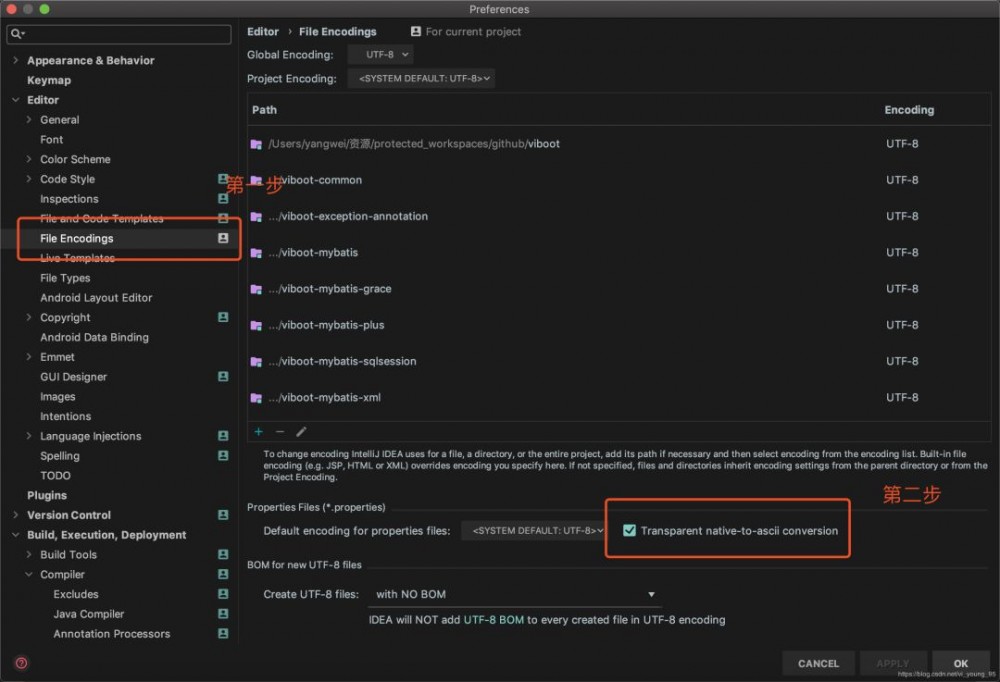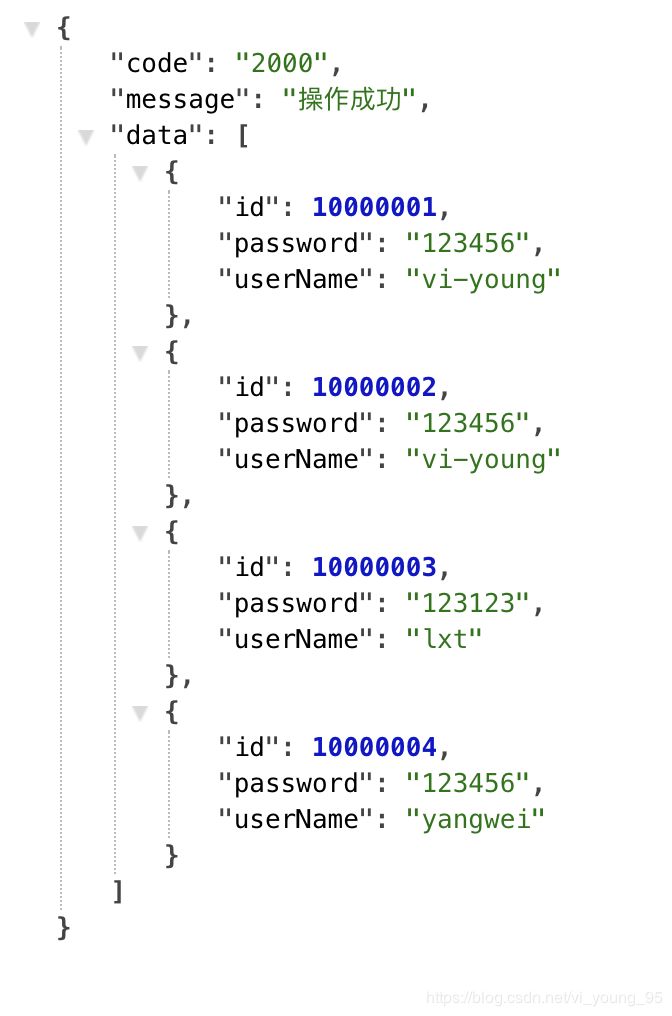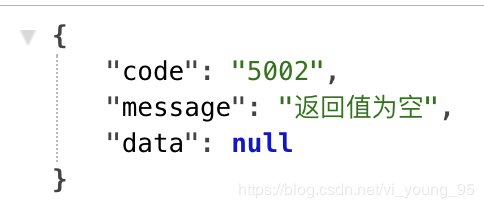Spring Boot 2.x(六):优雅的统一返回值
为什么要统一返回值
在我们做后端应用的时候,前后端分离的情况下,我们经常会定义一个数据格式,通常会包含 code , message , data 这三个必不可少的信息来方便我们的交流,下面我们直接来看代码
ReturnVO
package indi.viyoung.viboot.util;
import java.util.Properties;
/**
* 统一定义返回类
*
* @author yangwei
* @since 2018/12/20
*/
public class ReturnVO {
private static final Properties properties = ReadPropertiesUtil.getProperties(System.getProperty("user.dir") + "/viboot-common/src/main/resources/response.properties");
/**
* 返回代码
*/
private String code;
/**
* 返回信息
*/
private String message;
/**
* 返回数据
*/
private Object data;
public Object getData() {
return data;
}
public void setData(Object data) {
this.data = data;
}
public String getMessage() {
return message;
}
public void setMessage(String message) {
this.message = message;
}
public String getCode() {
return code;
}
public void setCode(String code) {
this.code = code;
}
/**
* 默认构造,返回操作正确的返回代码和信息
*/
public ReturnVO() {
this.setCode(properties.getProperty(ReturnCode.SUCCESS.val()));
this.setMessage(properties.getProperty(ReturnCode.SUCCESS.msg()));
}
/**
* 构造一个返回特定代码的ReturnVO对象
* @param code
*/
public ReturnVO(ReturnCode code) {
this.setCode(properties.getProperty(code.val()));
this.setMessage(properties.getProperty(code.msg()));
}
/**
* 默认值返回,默认返回正确的code和message
* @param data
*/
public ReturnVO(Object data) {
this.setCode(properties.getProperty(ReturnCode.SUCCESS.val()));
this.setMessage(properties.getProperty(ReturnCode.SUCCESS.msg()));
this.setData(data);
}
/**
* 构造返回代码,以及自定义的错误信息
* @param code
* @param message
*/
public ReturnVO(ReturnCode code, String message) {
this.setCode(properties.getProperty(code.val()));
this.setMessage(message);
}
/**
* 构造自定义的code,message,以及data
* @param code
* @param message
* @param data
*/
public ReturnVO(ReturnCode code, String message, Object data) {
this.setCode(code.val());
this.setMessage(message);
this.setData(data);
}
@Override
public String toString() {
return "ReturnVO{" +
"code='" + code + '/'' +
", message='" + message + '/'' +
", data=" + data +
'}';
}
}
在这里,我提供了几个构造方法以供不同情况下使用。代码的注释已经写得很清楚了,大家也可以应该看的比较清楚~
ReturnCode
细心的同学可能发现了,我单独定义了一个 ReturnCode 枚举类用于存储代码和返回的Message:
package indi.viyoung.viboot.util;
/**
* @author yangwei
* @since 2018/12/20
*/
public enum ReturnCode {
/** 操作成功 */
SUCCESS("SUCCESS_CODE", "SUCCESS_MSG"),
/** 操作失败 */
FAIL("FAIL_CODE", "FAIL_MSG"),
/** 空指针异常 */
NullpointerException("NPE_CODE", "NPE_MSG"),
/** 自定义异常之返回值为空 */
NullResponseException("NRE_CODE", "NRE_MSG");
private ReturnCode(String value, String msg){
this.val = value;
this.msg = msg;
}
public String val() {
return val;
}
public String msg() {
return msg;
}
private String val;
private String msg;
}
这里,我并没有将需要存储的数据直接放到枚举中,而是放到了一个配置文件中,这样既可以方便我们进行相关信息的修改,并且阅读起来也是比较方便。
SUCCESS_CODE=2000 SUCCESS_MSG=操作成功 FAIL_CODE=5000 FAIL_MSG=操作失败 NPE_CODE=5001 NPE_MSG=空指针异常 NRE_CODE=5002 NRE_MSG=返回值为空
注意,这里的属性名和属性值分别与枚举类中的value和msg相对应,这样,我们才可以方便的去通过I/O流去读取。
这里需要注意一点,如果你使用的是IDEA编辑器,需要修改以下的配置,这样你编辑配置文件的时候写的是中文,实际上保存的是ASCII字节码。

下面,来看一下读取的工具类:
package indi.viyoung.viboot.util;
import java.io.*;
import java.util.Iterator;
import java.util.Properties;
/**
* 读取*.properties中的属性
* @author vi
* @since 2018/12/24 7:33 PM
*/
public class ReadPropertiesUtil {
public static Properties getProperties(String propertiesPath){
Properties properties = new Properties();
try {
InputStream inputStream = new BufferedInputStream(new FileInputStream(propertiesPath));
properties.load(inputStream);
} catch (IOException e) {
e.printStackTrace();
}
return properties;
}
}
这里我直接写了一个静态的方法,传入的参数是properties文件的位置,这样的话,本文最初代码中的也就得到了解释。
private static final Properties properties = ReadPropertiesUtil.getProperties(System.getProperty("user.dir") + "/viboot-common/src/main/resources/response.properties");
使用ReturnVO
@RequestMapping("/test")
public ReturnVO test(){
try {
//省略
//省略
} catch (Exception e) {
e.printStackTrace();
}
return new ReturnVO();
}
下面我们可以去访问这个接口,看看会得到什么:

try...catch...
的存在,总是会让代码变得重复度很高,一个接口你都至少要去花三到十秒去写这个接口,如果不知道编辑器的快捷键,更是一种噩梦。我们只想全心全意的去关注实现业务,而不是花费大量的时间在编写一些重复的"刚需"代码上。
使用AOP进行全局异常的处理
(这里,我只是对全局异常处理进行一个简单的讲解,后面也就是下一节中会详细的讲述)
/**
* 统一封装返回值和异常处理
*
* @author vi
* @since 2018/12/20 6:09 AM
*/
@Slf4j
@Aspect
@Order(5)
@Component
public class ResponseAop {
private static final Properties properties = ReadPropertiesUtil.getProperties(System.getProperty("user.dir") + "/viboot-common/src/main/resources/response.properties");
/**
* 切点
*/
@Pointcut("execution(public * indi.viyoung.viboot.*.controller..*(..))")
public void httpResponse() {
}
/**
* 环切
*/
@Around("httpResponse()")
public ReturnVO handlerController(ProceedingJoinPoint proceedingJoinPoint) {
ReturnVO returnVO = new ReturnVO();
try {
//获取方法的执行结果
Object proceed = proceedingJoinPoint.proceed();
//如果方法的执行结果是ReturnVO,则将该对象直接返回
if (proceed instanceof ReturnVO) {
returnVO = (ReturnVO) proceed;
} else {
//否则,就要封装到ReturnVO的data中
returnVO.setData(proceed);
}
} catch (Throwable throwable) {
//如果出现了异常,调用异常处理方法将错误信息封装到ReturnVO中并返回
returnVO = handlerException(throwable);
}
return returnVO;
}
/**
* 异常处理
*/
private ReturnVO handlerException(Throwable throwable) {
ReturnVO returnVO = new ReturnVO();
//这里需要注意,返回枚举类中的枚举在写的时候应该和异常的名称相对应,以便动态的获取异常代码和异常信息
//获取异常名称的方法
String errorName = throwable.toString();
errorName = errorName.substring(errorName.lastIndexOf(".") + 1);
//直接获取properties文件中的内容
returnVO.setMessage(properties.getProperty(ReturnCode.valueOf(errorName).msg()));
returnVO.setCode(properties.getProperty(ReturnCode.valueOf(errorName).val()));
return returnVO;
}
}
如果,我们需要在每一个项目中都可以这么去做,需要将这个类放到一个公用的模块中,然后在pom中导入这个模块
<dependency>
<groupId>indi.viyoung.course</groupId>
<artifactId>viboot-common</artifactId>
<version>1.0-SNAPSHOT</version>
</dependency>
这里需要注意一点,必须保证你的切点的正确书写!!否则就会导致切点无效,同时需要在启动类中配置:
@ComponentScan(value = "indi.viyoung.viboot.*")
导入的正是 common 包下的所有文件,以保证可以将 ResponseAop 这个类加载到Spring的容器中。
下面我们来测试一下,访问我们经过修改后的编写的 findAll 接口:
@RequestMapping("/findAll")
public Object findAll(){
return userService.list();
}
PS:这里我将返回值统一为 Object ,以便数据存入 data ,实际类型应是 Service 接口的返回类型。如果没有返回值的话,那就可以 new 一个 ReturnVO 对象直接通过构造方法赋值即可。关于返回类型为 ReturnVO 的判断,代码中也已经做了特殊的处理,并非存入 data ,而是直接返回。

下面,我们修改一下test方法,让他抛出一个我们自定义的查询返回值为空的异常:
@RequestMapping("/test")
public ReturnVO test(){
throw new NullResponseException();
}
下面,我们再来访问以下test接口:

可以看到,正如我们properties中定义的那样,我们得到了我们想要的消息。
原创文章,文笔有限,才疏学浅,文中若有不正之处,万望告知。
源码可以去点击阅读原文去GitHub上进行下载,后续的例子都会同步更新。
云撸猫

公众号












![[HBLOG]公众号](https://www.liuhaihua.cn/img/qrcode_gzh.jpg)

